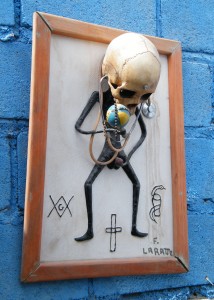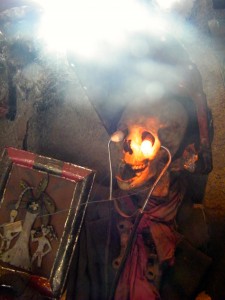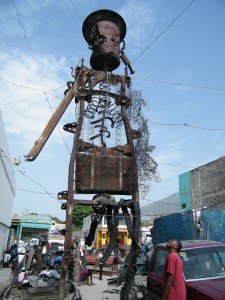A Conversation with André Eugène
A Conversation with André Eugène
Dedicated to Wender Thelisma, one of the Ti moun rezistans. RIP.
Born and reared, and now based, in Port-au-Prince, André Eugène is one of Haiti’s most provocative and innovative contemporary artists. His work is built from the kind of materials that one—especially in the global North—might describe as trash or scrap pieces, but in Eugene’s hands become a means for transformative art: addressing the complexity of Vodou; Haiti’s economic and social crises; sexuality; and mortality. But Eugène’s use of “found materials” is more than just access and availability for his sculptures; he and his fellow Atis rezistans, an art collective led by Eugène and formed on Port-au-Prince’s bustling Grand Rue, are what Donald J. Consentino calls the “most emblematic artists to emerge in the period between the collapse of Aristide’s government in 2004 and the earthquake of 2010.”1
Moreover, the group demonstrates the power of working with, as Ella Shohat and Robert Stam theorize about garbage, “the same commodities that had been fetishized by advertising, dynamized by montage, and haloed through backlighting, are now stripped of their aura of charismatic power.”2 While there is certainly a sense of what Shohat and Stam call the “artistic ju-jitsu and ironic reappropriation” made possible in transmuting junk into art, Eugène’s critique of broader consumer culture is just one facet of his work.3 He and his fellow Atis rezistans incorporate locally specific points of reference that include “not only the nearby Vodou temples and National Cemetery (source for the human skulls that have added to the notoriety of the work), but the hipper galleries of Pétionville, and avant-garde studio artists such as Mario Benjamin, Jean Camille Nasson, and Eduoard Duval Carrié.”4
One of the most important avant-garde figures in Haiti’s art scene, Eugène is also the cocurator of the Ghetto Biennale, which first took place in 2009 and brings artists and their work from around Haiti, the greater Caribbean, and the rest of the world to the downtown streets of the nation’s capital. Despite the challenges of convening an international artistic event in the aftermath of the 2010 earthquake, the Ghetto Biennale was held again in 2011, continuing to question first- and third-world conceptions of art, or, as British photographer, filmmaker, and cocurator Leah Gordon puts it, “What happens when first world art rubs up against third world art? Does it bleed?”5 The tension between artistic production in the so-called third-world and the way it is viewed by its “first-world” counterparts will be addressed again when the third Ghetto Biennale ensues in November 2013.
As cofounder of the Atis rezistans, Eugène is also mentor to a group of younger cutting-edge artists. With the Port-au-Prince collective, Eugène builds both a strong local art scene and sets the precedent about how Haitian art can not only be shown around the world, but that contemporary Haitian artists can participate in the global art marketplace. Through the creation of a website that details both his own work and numerous other members of the collective, André Eugène and his fellow Atis rezistans have been able to create an audience beyond Haiti (www.atis-rezistans.com/about.php). In recent years, work from members of the collective has been exhibited in Venice, Paris, New York, and London. Eugène’s art, like other that of members of the Atis rezistans, is uncompromising, utilizing objects such as human skulls and discarded toys; yet, through this avant-garde approach, he has helped to forge a uniquely Haitian—or, in fact, distinctly Port-au-Prince—style. And by using found materials to create ambitious and intriguing art, Eugène has given birth to what he calls the “currency of the Ghetto.” His is art drawn from life in Port-au-Prince’s downtown streets that circulates out to the world’s metropolises. After I spoke with three of the up-and-coming members of the Atis Rezistans—Romel Jean Pierre, Racine Polycarpe, and Claudel Casseus—at the Atis rezistans “headquarters” off the Grand Rue in Port-au-Prince, I contacted Eugène for an interview via e-mail in November 2012. The interview segment is translated by Leah Gordon.
Christopher Garland: What attracted you to the medium of sculpture? And what does it allow you to express in regard to what you have referenced as major themes: politics, death (for example, the earthquake), and the experience of the Haitian people?
André Eugène: I was trained as a sculptor. This neighborhood—Grand Rue—traditionally produces woodcarving. Many years ago, these [pieces] were for the tourist trade, but now more of [the] works get shipped to the Dominican Republic rather than the Iron Market (in downtown Port-au-Prince). So, it is easy to learn the skills of woodcarving in this area. My sculpture allows me to express my life and my culture and my economic reality.
Figure 1: Atis Rezistans, Gede with Bugle, n.d. Bone on canvas, with assorted materials; 25 in. x 9.5 in. E pluribus unum musee d’art, Port-au-Prince, Haiti. Photograph by Christopher Garland.
Note: When asking several of the artists who made which pieces, they would say that due to the collective nature of the Atis rezistans, they did not necessarily see a piece as one individual’s work. Also, when asked the title of the piece, they would often simply “name” it in accordance with what it represented (for example, Gede or Bawon Samedi).
CG: One of the most immediate and striking aspects of your work is your use of found material (metals, wood pieces, plastics). First, alongside the accessibility of these materials, what do these materials allow you to do and express with your sculptures? Second, what are the limitations of “recycled art”?
AE: Sometimes I find some materials and they immediately tell me what they will express. The form of the recycled materials speaks to me and sparks my imagination, leading me to what I will represent: as in the Bin Laden sculpture, which came to me once I saw the muffler. I find there are no limits . . .
CG: In an interview six months after the earthquake you said, “Look at my art and look at Haitians. . . . Look at my art and look at resistance, look at resilience.” Expanding on these two terms as central to your art, what do resistance and resilience mean in relation to your own work today?
AE: I recycle iron and tires, both of which are very hard, and this reflects resistance for me. We have a proverb in Haiti that says, “Iron doors do not fight with wooden doors.” For example, when you put iron and wood together they create something with even greater strength.
CG: One of the things that viewing your work online cannot convey is the experience of being in your yard/work space. How would you describe E pluribus unum musee d’art to someone who hasn’t seen it? And what is the significance of its name?
AE: Yes, well if you view anything on a screen it is different to the reality. You can see my environment better in the film Atis Rezistans: Sculptors of the Grand Rue. It is a museum in a yard with all the works of different artists mixed together. The name [E pluribus unum] means [to me] “One for All, All for One.” The dollar is a money you can use all over the world: in the United Kingdom, Zimbabwe—all over the world—and we hope that our art can speak to people all over the world too. It is a currency: the currency of the Ghetto.
CG: You have cited the influence of Vodou in your work. Could you explain how you’ve incorporated Vodou iconography/symbolism into your work, and the importance of this to you as an artist?
AE: I use the penis for Gede, the cross for the Baron Samedi, the snake for Danballah, and the woman with child is Dantor. It is all important as we live in a country of Vodou.
Figure 2: Atis Rezistans, Bawon Samdi, n.d. Wood, 34 in. x 6 in. E pluribus unum musee d’art, Port-au-Prince, Haiti. Photograph by Christopher Garland.
CG: Some audiences—both in Haiti and abroad—might be shocked (particularly due to stereotypes about Vodou) by the use of one particular kind of material: human skulls and bones. Please explain the process of acquiring these materials, the importance of them to your work, and what reaction you’ve experienced to this facet of your art?
AE: In my work, when I have used someone’s skull . . . [I know] this man was Haitian: when he was alive, he couldn’t travel anywhere, and it is ironic that now he is dead he has visited Chicago, Barbados, and Florida. Our use of skulls and bones relate to Vodou symbolism, Vodou altars—but also the lack of mobility of the Haitian people. Also, we in Haiti have the detritus of Western culture dumped onto us and we recycle and use it and sell it back to the West. The skulls are the only recycled material that is made in Haiti.
CG: How did the Atis rezistans collective develop? And how did you get the involvement of teenagers and children?
AE: First, we were known as the Sculptors of Grand Rue, then an article in the Nouvelliste said our work is work of resistance. We first used the word when we created our website. After that more and more artists in the neighborhood joined us. Later, we did a workshop at Columbia College Chicago, and we decided to start working with children in Haiti, too.
Figure 3: Atis Rezistans, Skull with Stethoscope, n.d. Bone on metal, 10 in. x 7 in. E pluribus unum musee d’art, Port-au-Prince, Haiti. Photograph by Christopher Garland.
CG: How important is the collaborative element of the Atis rezistans to you? And is there a shared vision amongst the artists on the notion of rezistans? And what has been the most rewarding aspect of being a leader of the group? What has been the most frustrating aspect?
AE: We work together, live together, share skills and ideas and support each other. Yes, we all share a notion of resistance. Everywhere you can find leaders and I think I have the qualities of a leader. I like to fight for the whole team. Sometimes I try to speak for Atis rezistans and worry that I do not represent everyone well enough. I can speak English, but I am frustrated that sometimes others could have a voice, as I cannot speak for everyone.
Figure 4: Atis Rezistans, Bawon Samdi, 2002. Metal, 40 ft. x 5 ft. E pluribus unum musee d’art, Port-au-Prince, Haiti. Photograph by Christopher Garland.
Note: This representation of Bawon Samdi, which survived the earthquake of 12 January 2010, was destroyed by a tornado on 16 July 2012.
CG: Do you think there is a distinction between being a Haitian artist and also being a Port-au-Prince artist? By this I mean, how does the urban space of Port-au-Prince influence your work?
AE: I was born in downtown Port-au-Prince, and I have never lived in the countryside. The urban environment colors all the work we make, from the materials we find to the energy generated from our frustration with the urban environment.
Christopher Garland is a PhD candidate in the Department of English at the University of Florida. His current work addresses contemporary visual representations of Haiti, and his most recent publication is “The Rhetoric of Crisis and Foreclosing the Future of Haiti in Ghosts of Cité Soleil” in Haiti and the Americas (2013). He has also contributed to the joint University of Florida–Duke University Vodou Archive. www.christopherjgarland.com
________________
1 Donald J. Consentino, In Extremis: Death and Life in Twenty-First-Century Haitian Art (Los Angeles: Fowler Museum at UCLA, 2012), 54.
2 Ella Shohat and Robert Stam. “Narrativizing Visual Culture: Towards a Polycentric Aesthetics,” in Nicholas Mizroeff, ed., The Visual Culture Reader (New York: Routledge, 2012), 45.
3 Ibid.,53.
4 Constentino, In Extremis, 54.
5 Comments made during a presentation at Haiti in a Globalized Frame, an international conference hosted by the Winthrop-King Institute for Contemporary French and Francophone Studies at Florida State University, February 2013. “What happens when first world art rubs up against third world art? Does it bleed?” was the title of the first Ghetto Biennale in 2009; www.ghettobiennale.com/.



